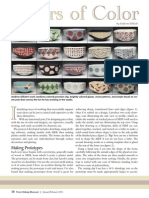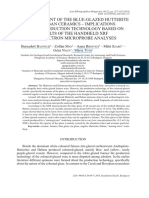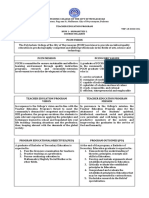Cerartsanto
Cerartsanto
Uploaded by
Lucia Sueli TaguchiCopyright:
Available Formats
Cerartsanto
Cerartsanto
Uploaded by
Lucia Sueli TaguchiOriginal Title
Copyright
Available Formats
Share this document
Did you find this document useful?
Is this content inappropriate?
Copyright:
Available Formats
Cerartsanto
Cerartsanto
Uploaded by
Lucia Sueli TaguchiCopyright:
Available Formats
Amy Santoferraro
Plate-O-Matic
by Paul Andrew Wandless
Ceramic Art
my Santoferraro combines just about any process, method or material with clay if it enables her to ultimately achieve the visual result her work requires. Shes not alone in combining different methods and techniques with clay for new and more efficient ways to create work. Its more popular than ever these days to seek out different processes to use with clay and the work created is aesthetically exciting and fresh as a result. One such combination of processes is screen printing directly onto clay, then using plaster molds with thick springy foam to press-form the clay slabs into a variety of shapes. This method is fairly quick to do from start to finish and has even earned the name Plate-O-Matic due to its ease of use and predictable reliability. Ceramic artist Linda Casbon was giving a collectors workshop at Watershed Center for the Ceramic Arts and Amy was her assistant. Linda taught this method (which she learned from one of her students) to Amy during this time. Amy has since put her own unique twist on the ba-
sic process using screens. I always enjoy hearing these stories about how everyone learns from each other regardless of who is the teacher and who is the student! Clay folk are always happy to learn from anyone and then share with everyone. You can create a shallow platter with a two-color, screen printed image using the following two-stage process. The first stage is to create the image by screening directly onto a prepped clay slab, and the second stage is to press-form the printed slab with a plaster hump mold into a thick, springy piece of foam.
Silk Screening Images
Amy transfers images onto clay using a silkscreen process. In this example, she begins with a rectangular-shaped slab of clay about 3/8 inch thick, which she smooths with a rub-
21
Ceramic Arts Handbook
Tools and supplies for this process include simple hump/drape molds and 3-inch blocks of soft foam. Texturing tools, cutters and printing supplies are all optional.
ber rib. The slab should be roughly 3 inches larger than the hump mold youre planning on using to assure it conforms to the whole shape. (Note: Amy uses terra cotta for this demo, but any clay body can be used.) For a base color, she then coats the surface with porcelain slip (figure 1) brushed evenly across the entire surface with a wide brush. Once the slip dries a bit and the shine is gone, she smooths it with a rubber rib to remove any brush marks (figure 2). Although porcelain slip is used here, you can use any white or tinted slipwhatever background you want for your piece. Tip: Prep two or three slabs at a time so you have extras to work with.
emulsion. Each screen is printed using a different color with the first screen being the background pattern and the second screen the primary image. Commercial underglazes need to be the right consistency for silk screening to avoid bleeding edges on the image. To get underglazes to the consistency of honey, Amy leaves them open overnight so some of the water can evaporate. Before printing on the clay, you need to load the open areas of the silk screen with color. Amy applies a bead of underglaze across the length of the screen (figure 3), then using a squeegee with a stiff rubber blade, she draws the underglaze across the screen into the open areas (figure 4). Next, she applies another bead of slip on the screen then carefully lowers the screen onto the clay slab
Screen a Two-Color Image
To make a two-color print, Amy uses two screens with images burned into them using diazo photosensitive
22
Ceramic Art
Prepare a slab and coat with slip.
Use a rib to smooth the surface.
Place a bead of slip on the silk screen.
Use a squeegee to charge the screen.
Place another bead of slip on the screen.
Carefully place the screen over the slab.
(figures 56). Once in place, she screens the image onto the slab creating a background of light blue circles (figure 7). The second screen has several images in it so Amy uses wax paper on the bottom of the screen to block out all the images not being used (figure 8). The screen is then loaded with thickened black underglaze, lined up over the slab and screened over the blue circles (figure 9). The finished image is left to dry for 15 20 minutes or until its dry to the touch. Once the image is dry, check
the slab to see if it has stiffened enough to handle but is still flexible (figure 10).
Forming the Plate
Center the clay slab on a piece of thick springy foam and use a damp sponge to clean the surface of the plaster hump mold (figure 11). Be sure the piece of foam is larger than the mold being used. Place the mold over the area of the print that will be the final composition, taking into consideration how the shape and depth of the mold will interact
23
Ceramic Arts Handbook
Squeegee slip to transfer the design to the slab.
Mask off areas of the screen you will not use.
A second screen with a second color is added.
10
11
12
Allow one slab to set up, but make sure it is still flexible.
Place slab on foam rubber and prepare a mold.
Trim excess clay from the slab before pressing.
with the image you created. Trim a wide border, leaving enough clay to conform to the mold (figure 12) and remove the excess slab. Keep your trimming tool handy because youll need it after forming the plate. Place both hands on the mold and press with slow even pressure until the back of the mold is roughly even with the surface of the foam (figure 13). While keeping pressure on the mold, trim and remove excess clay from the edge of the mold to create the rim (figure 14). Amy cuts at an angle so the rim also acts as a bor-
der. If you cut straight down, the rim will have more of an edge where the image or design would end at the perimeter.
Finishing Touches
To finish the plate, keep one hand on the mold, and flip the plate and remove the foam. Use a rubber rib to smooth the bottom of the plate (figure 15). Once the bottom is finished, flip the plate back over and remove the mold (figure 16). Finish the rim with a Surform tool and rubber rib. Amy hand-glazed additional images on her plate. The finished piece
24
Ceramic Art
13
14
15
Use even pressure and press mold into clay.
Hold mold down and trim remaining excess.
Keep slab on mold and use rib to smooth the surface.
16
17
18
Place the completed piece on flat surface and remove mold.
As a variation, create a decorative edge prior to molding.
Press slab into foam.
looks wonderful and was simple to make. Once you have prepared slabs, this whole press forming process should only take about 15 minutes per plate.
shape that you designed yourself. Trace and carve the shape of its perimeter into the clay creating the edge of your plate (figure 17). Use stamps with interesting designs or patterns to emboss a design, pattern or composition into the clay; then line up the plaster mold and press into the foam creating the depth desired for the piece (figure 18). Once the form is pressed, remove and clean up with a rubber rib and other finishing tools as needed. This is a really simple way to create a plate with a complex embossed design
Templates and Stamping
Like most techniques, you can vary this process. If screening isnt your thing, try one of these alternatives to make plates or bowls that are even quicker to perform and use common items. Choose a template or form with an interesting profile or edge. This can be a plastic form or even a drawn
25
Ceramic Arts Handbook
19
20
Piece showing scalloped edge and texture added before pressing.
Add feet to the bowls made with this process if desired.
(figure 19). Glaze or slip can be applied in the recessed areas (mishma technique) or a simple celadon can be applied. For more variations, try using cookie cutters, pastry or tart pans or small dough cutters and cut out forms. Press the clay into the foam with a half-sphere plaster mold and add a foot if desired. Leave the mold inside to act as resistance to press against when making the foot. Amy uses a small coil and attaches and smooths it with her fingers (figure 20). A damp sponge can also be used to run around the foot for final
smoothing of the surface. These are just two variations that can be applied to this Plate-O-Matic method, and the possibilities really are endless. Just keep a few things in mind when experimenting with this process. Remember that the hump mold youre using must be slightly smaller than the slab so youre sure to get a good rim after pressing into the foam. The foam itself needs to be at least 4 inches thick and springy so you can achieve good depth in the plates or bowls. Seat cushions work well or you can get thick springy foam at a craft store.
26
You might also like
- Creating A EngobeDocument105 pagesCreating A Engobeduyen nguyen chi luongNo ratings yet
- Ceramics VocabularyDocument3 pagesCeramics VocabularyRennik McCaigNo ratings yet
- Mason High - Ceramics 2 - Centerpiece Lesson PlanDocument4 pagesMason High - Ceramics 2 - Centerpiece Lesson Planapi-267189611No ratings yet
- Wood TurningDocument166 pagesWood Turningpastorjmcgouirk100% (1)
- Pallasmaa - in Praise of VaguenessDocument17 pagesPallasmaa - in Praise of Vaguenessandjela1111100% (3)
- Making Prototypes: by Andrew GilliattDocument5 pagesMaking Prototypes: by Andrew GilliattFractalzNo ratings yet
- Underglaze: Users GuideDocument23 pagesUnderglaze: Users GuideGabriela Motta100% (1)
- Translucent PorcelainDocument4 pagesTranslucent PorcelainMarjorie Agreda100% (1)
- Large Pots - Bill ShinnDocument4 pagesLarge Pots - Bill ShinnStefan Van Cleemput100% (2)
- Five Great Pottery Decorating TechnuquesDocument20 pagesFive Great Pottery Decorating Technuquesw0rlds100% (1)
- 407 Studio Process Sheet Ceramics 2Document5 pages407 Studio Process Sheet Ceramics 2api-583626725100% (1)
- The Upside - Down Bowl: by Martina LantinDocument4 pagesThe Upside - Down Bowl: by Martina LantinParaSemore Vivendo100% (1)
- Jake Allee ND07Document4 pagesJake Allee ND07Stefan Van CleemputNo ratings yet
- Cley TermsDocument1 pageCley Termsapi-402226857No ratings yet
- Ceramics PowerpointDocument20 pagesCeramics Powerpointapi-261533313No ratings yet
- Staying TrimDocument4 pagesStaying TrimStefan Van CleemputNo ratings yet
- La Meridiana Notes Paperclay PDFDocument3 pagesLa Meridiana Notes Paperclay PDFAnonymous FF4JjPdgNo ratings yet
- Ceramic: For Other Uses, See - A Ceramic Is An, NonmetallicDocument7 pagesCeramic: For Other Uses, See - A Ceramic Is An, Nonmetallicletter_ashish4444No ratings yet
- 43vocabulary Basic CeramicsDocument6 pages43vocabulary Basic CeramicsReshmi VarmaNo ratings yet
- Getting Handle On CaneDocument5 pagesGetting Handle On CaneStefan Van Cleemput100% (2)
- PotteryDocument29 pagesPotteryIndra AwasthiNo ratings yet
- 0 York Dec15cmDocument4 pages0 York Dec15cmapi-24483605No ratings yet
- Advanced Ceramics SyllabusDocument4 pagesAdvanced Ceramics Syllabusapi-285550989No ratings yet
- Wednesday, 9/8: - Course Fee Collected Mark You're Your Extra Credit in My Gradebook!Document29 pagesWednesday, 9/8: - Course Fee Collected Mark You're Your Extra Credit in My Gradebook!room46No ratings yet
- Salt Glazed Clay SurfacesDocument67 pagesSalt Glazed Clay SurfacesMilen SolakovNo ratings yet
- Year 9 Powerpoint For Weebly of Ceramic Artists To InspireDocument35 pagesYear 9 Powerpoint For Weebly of Ceramic Artists To Inspireapi-252776499100% (2)
- Preparing & Storing GlazeDocument4 pagesPreparing & Storing GlazeGianmarcoMolinaNo ratings yet
- Esmaltes Varios en Inglés FABIDocument8 pagesEsmaltes Varios en Inglés FABIclaul66100% (1)
- Ceramic FritsDocument2 pagesCeramic Fritslaklain100% (1)
- Successful Tips & Techniques For: Raku FiringDocument26 pagesSuccessful Tips & Techniques For: Raku FiringGilson Goulart CarrijoNo ratings yet
- An Improved Pottery KilnDocument9 pagesAn Improved Pottery KilnTefera Adugna100% (2)
- Betty WoodmanDocument22 pagesBetty WoodmanMargaret MillerNo ratings yet
- Five Great Pottery Wheel: Throwing TechniquesDocument22 pagesFive Great Pottery Wheel: Throwing TechniquesJacqueline De MaillardNo ratings yet
- A 1 CeramicshandoutDocument2 pagesA 1 Ceramicshandoutapi-100055467No ratings yet
- Clay and Glaze MaterialsDocument28 pagesClay and Glaze Materialsapi-26965779100% (2)
- STA Decorating SlipDocument2 pagesSTA Decorating SlipmohanNo ratings yet
- 08 Chapter 4Document8 pages08 Chapter 4Ali AliNo ratings yet
- Material Substitutions For Clay BodiesDocument11 pagesMaterial Substitutions For Clay BodiesGreg CampbellNo ratings yet
- Roger GrahamDocument3 pagesRoger GrahamStefan Van CleemputNo ratings yet
- Crystalline Glaze Class Dan DermerDocument4 pagesCrystalline Glaze Class Dan DermerJesus MorenoNo ratings yet
- Ceramics Monthly (June 1959)Document44 pagesCeramics Monthly (June 1959)Wade MacMorrighan100% (2)
- The Sweet Life - Ceramics: Art & PerceptionDocument4 pagesThe Sweet Life - Ceramics: Art & PerceptionBlair SchulmanNo ratings yet
- Basic Slip CastingDocument3 pagesBasic Slip Castingnataliebuffalo100% (2)
- Stoneware MaturityDocument3 pagesStoneware MaturityLNo ratings yet
- 15 Cone 10 RecipesDocument10 pages15 Cone 10 RecipesInga NowakNo ratings yet
- How To Design, Make, and Install and Murals: Ceramic TilesDocument19 pagesHow To Design, Make, and Install and Murals: Ceramic TilesChanrath100% (1)
- Mixing Slip, Plaster Mold Fabrication, Slip-CastingDocument4 pagesMixing Slip, Plaster Mold Fabrication, Slip-CastingLauraNo ratings yet
- Rcoppage Cmmarpdf FinalDocument2 pagesRcoppage Cmmarpdf Finalapi-308735650100% (1)
- Firing Temperatures: & Cone EquivalentsDocument2 pagesFiring Temperatures: & Cone EquivalentsIcy45No ratings yet
- Glaze MaterialsDocument7 pagesGlaze MaterialssmiNo ratings yet
- Raku Firing PDFDocument13 pagesRaku Firing PDFDianaNo ratings yet
- Ceramics Coil ConstructionDocument31 pagesCeramics Coil Constructionapi-281422205No ratings yet
- CeramicColor PDFDocument12 pagesCeramicColor PDFSiddharthapachisiaNo ratings yet
- Raku Firing Rad CADocument6 pagesRaku Firing Rad CAStefan Van CleemputNo ratings yet
- Soda Firing Techniques NewDocument21 pagesSoda Firing Techniques NewStefan Van Cleemput100% (2)
- Ceramic Sculpture GordonDocument4 pagesCeramic Sculpture GordonHugo De Oliveira AssisNo ratings yet
- Introduction To CeramicsDocument29 pagesIntroduction To CeramicsShrikrishna BirajdarNo ratings yet
- The Potter's Craft: A Practical Guide for the Studio and WorkshopFrom EverandThe Potter's Craft: A Practical Guide for the Studio and WorkshopNo ratings yet
- Origin and Development of Form and Ornament in Ceramic ArtFrom EverandOrigin and Development of Form and Ornament in Ceramic ArtNo ratings yet
- The Saggar Maker's Bottom Knocker, or The Story of Pottery in a BoxFrom EverandThe Saggar Maker's Bottom Knocker, or The Story of Pottery in a BoxNo ratings yet
- NHunter - Clan IssuesDocument9 pagesNHunter - Clan IssuesMike JuubiNo ratings yet
- PLASTERINGDocument11 pagesPLASTERINGAnushka KhatriNo ratings yet
- Listening 2 - K44 - Listening Log #2 Answer SheetDocument8 pagesListening 2 - K44 - Listening Log #2 Answer SheetNguyen Thi My Huyen K66No ratings yet
- Frame Construction 101: This Article's CompositionDocument17 pagesFrame Construction 101: This Article's CompositionDEEPAK GROVERNo ratings yet
- Q4 - MAPEH - Week 1Document9 pagesQ4 - MAPEH - Week 1MAE HERNANDEZNo ratings yet
- AM Studio - Photography Services (2023)Document5 pagesAM Studio - Photography Services (2023)Qairahijab MarketingNo ratings yet
- Contoh Proposal KPDocument9 pagesContoh Proposal KPMohammad FarhanNo ratings yet
- Chapple, R. M. 2014 New Adventures With High Crosses - Clogher, Co. Tyrone. Blogspot PostDocument7 pagesChapple, R. M. 2014 New Adventures With High Crosses - Clogher, Co. Tyrone. Blogspot PostRobert M ChappleNo ratings yet
- Acta Ethnographica Hungarica 60 - 517 - 534 - Bajnóczi Et Al PDFDocument18 pagesActa Ethnographica Hungarica 60 - 517 - 534 - Bajnóczi Et Al PDFGermanikNo ratings yet
- Kiaer Christina Imagine No Possessions The Socialist Objects of Russian ConstructivismDocument363 pagesKiaer Christina Imagine No Possessions The Socialist Objects of Russian ConstructivismAnalía Capdevila100% (2)
- Arts8 Q1 DLP1Document5 pagesArts8 Q1 DLP1Jeraldine Mantilla BrigoleNo ratings yet
- 03 Types of Monologues1Document1 page03 Types of Monologues1adrianaNo ratings yet
- Art Conus CoelinaeDocument4 pagesArt Conus CoelinaeÁngel Cruz ArrayzNo ratings yet
- Adele 25 PDFDocument67 pagesAdele 25 PDFphuongboulevardNo ratings yet
- Making Wax CrayonsDocument4 pagesMaking Wax Crayonslegend_grooveyNo ratings yet
- 01A-2 Power Supply Before Contact XLRTEH4300G038443Document6 pages01A-2 Power Supply Before Contact XLRTEH4300G038443НиколайNo ratings yet
- Skima Markah Akhir 2015Document8 pagesSkima Markah Akhir 2015Mohd Karafi Md SallehNo ratings yet
- Closeryouand IDocument21 pagesCloseryouand ISalie CerbitoNo ratings yet
- Blackman, Archaeological Reports 2001-2002Document116 pagesBlackman, Archaeological Reports 2001-2002laduchessNo ratings yet
- Video Editing ResumeDocument1 pageVideo Editing ResumeusmanoptimizerzNo ratings yet
- Humanities 1 SyllabusDocument6 pagesHumanities 1 SyllabusEder Aguirre CapangpanganNo ratings yet
- Flares Over-The-Top Beginners Guide To SFXv2.1Document57 pagesFlares Over-The-Top Beginners Guide To SFXv2.1L VNo ratings yet
- Ppt.-Lesson 4Document31 pagesPpt.-Lesson 4maria genioNo ratings yet
- Arnis - Anyo Isa - Form OneDocument1 pageArnis - Anyo Isa - Form OneJerry Don Smith, Jr.No ratings yet
- ACMI Rear Window Study GuideDocument36 pagesACMI Rear Window Study GuideMarcos GonzálezNo ratings yet
- Bardwell Choir Permission Slip 2013-2014Document2 pagesBardwell Choir Permission Slip 2013-2014api-235451237No ratings yet
- 4 Color Still Life Lesson PlanDocument16 pages4 Color Still Life Lesson Planapi-91265487No ratings yet
- Embroidery Stitches A To ZDocument22 pagesEmbroidery Stitches A To ZSundaramoorthy Manickam75% (4)

























































































